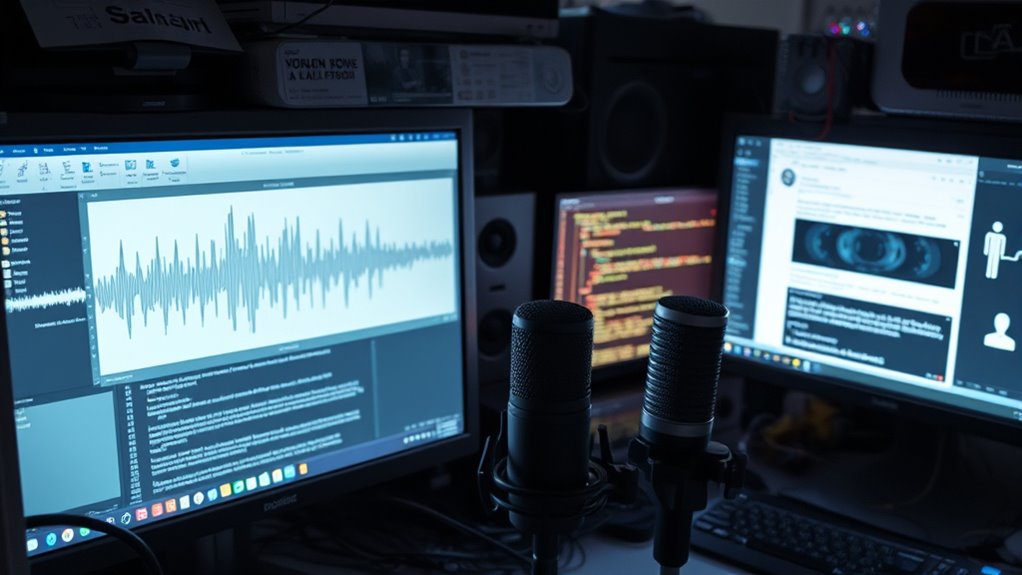AI voice clones are transforming phishing, making scams more believable and harder to detect than traditional email filters can handle. Cybercriminals use deepfake and AI synthesis tools to craft personalized, realistic audio impersonations of trusted contacts, bypassing common security measures. They gather data from social media and recordings to tailor attacks that exploit human trust. If you want to understand how these advanced threats operate and learn effective defense strategies, keep exploring further.
Key Takeaways
- AI voice clones bypass traditional email filters by mimicking human speech patterns and emotional nuances, making detection difficult.
- Advanced deepfake and voice synthesis technologies enable personalized, convincing scams that evade signature-based defenses.
- Traditional email security relies on static rules, which AI-generated content can easily bypass with evolving, adaptive tactics.
- Voice impersonation scams exploit real recordings and behavioral profiling to craft credible, targeted attacks.
- Organizations need behavioral and AI-driven detection strategies beyond standard filters to combat sophisticated AI voice phishing.
The Rise of AI-Generated Voice Impersonation in Phishing

The rise of AI-generated voice impersonation has transformed phishing attacks, making them more convincing and harder to detect. About 70% of people struggle to tell real voices from AI clones, increasing your risk of falling for scams. Nearly one in ten adults worldwide has encountered AI voice scams, often with significant financial consequences—77% of victims report losses. Older adults, especially those over 60, are 40% more vulnerable when accessing sensitive data. Cybercriminals now use real voice recordings to craft highly believable fake audio, impersonating trusted figures like executives. They leverage publicly available data to create detailed behavioral profiles, making their impersonations more precise. These sophisticated techniques, combined with continuous AI evolution, make voice phishing a growing and dangerous threat. Research indicates that advancements in AI voice synthesis are accelerating, enabling even more realistic impersonations that can bypass traditional detection methods. Additionally, the development of sound design techniques allows scammers to craft immersive audio environments that further deceive their targets.
Limitations of Traditional Email Security Protocols Against AI Attacks

Traditional email security protocols often depend heavily on signature-based detection and static rules to identify threats. These methods quickly become outdated as AI-generated phishing emails evolve faster than signature databases can update. Over 80% of phishing emails now use AI to bypass pattern-matching techniques, making traditional defenses less effective. Human-crafted heuristic rules can’t keep pace with AI’s diversity, leaving many attacks undetected. Additionally, the color accuracy of detection systems is limited, making it difficult to distinguish sophisticated AI-crafted content from legitimate messages.
How Deepfake Technology Is Transforming Voice Phishing Tactics

Deepfake technology makes voice cloning more realistic than ever, allowing scammers to convincingly imitate trusted contacts in seconds. With rapid deployment, attackers can launch personalized scams that exploit your trust and urgency. This shift dramatically increases the success rate of voice phishing, making it harder for you to distinguish genuine calls from fake ones. Incorporating proper security measures can help mitigate these risks.
Realistic Voice Cloning
Advancements in AI voice cloning technology are making fake voices nearly indistinguishable from real ones, profoundly transforming how voice phishing attacks operate. Tools like Lyrebird AI and Voxygen create highly accurate, emotionally nuanced voice clones that blur the line between genuine and synthetic speech. With models such as WaveNet and Tacotron, the realism of these voices has skyrocketed, making impersonations more convincing than ever. Features like customizable accents, pacing, and tone add authenticity, increasing the challenge of detection. As these technologies become more accessible, fraudsters can effortlessly produce lifelike voices for scams, impersonations, or misinformation campaigns. The growing market value and improved metrics like MOS and TAR highlight just how convincingly real these cloned voices now sound, raising serious ethical and security concerns. Voice cloning’s ability to analyze vast audio data and reproduce tone, pitch, and emotion continues to push the boundaries of what is possible in synthetic speech, making detection even more difficult.
Rapid Attack Deployment
AI voice cloning technology has revolutionized how quickly attackers can launch and scale voice phishing (vishing) campaigns. Automated voice synthesis tools let you create dozens or even hundreds of unique calls in a short time, increasing exposure and success chances. Pre-recorded or AI-generated responses enable interactive, adaptive calls without requiring much human effort, speeding up deployment. Attackers can leverage online meeting recordings or public speeches to rapidly clone voices for different targets or organizations. Lower skill barriers, thanks to growing AI infrastructure and open-source tools, allow more threat actors to execute these attacks swiftly. Furthermore, the use of personalized messaging enhances the credibility of these calls, making them even more convincing and difficult to detect. Combining this speed with sophisticated social engineering—like impersonating IT support or executives—makes these campaigns highly effective and hard to detect, amplifying their impact on organizations.
Trust Exploitation
As voice cloning technology becomes more sophisticated, attackers can now mimic not just the tone and pitch but also emotional nuances and regional accents, making their impersonations more convincing. They craft emotion-aware, multilingual voice models with minimal data—sometimes just 30 to 90 seconds of audio—enabling highly realistic impersonations of executives, family members, or help desk agents. This emotional replication boosts trust, increasing the likelihood victims will comply with scam requests. Unfortunately, people can only detect AI-generated voices about 60% of the time, leaving many vulnerable, especially the elderly who often share voice data online. Over half of adults worldwide share their voice data weekly, fueling these attacks. Research indicates that the accuracy of AI voice impersonation continues to improve rapidly, further diminishing the chances of detection. The rapid advancements in voice synthesis make it increasingly difficult to distinguish between real and AI-generated voices.
The Costly Impact of AI-Driven Voice Phishing on Organizations

The rise of voice phishing scams powered by advanced generative models has dramatically increased the financial and operational costs for organizations. On average, a phishing breach now costs nearly $4.88 million, with voice scams alone causing about $14 million annually per affected company. Globally, AI-enhanced vishing contributed to approximately $39.5 billion in losses in 2024. These scams target vulnerable sectors like customer support, where sensitive data is easily accessible, increasing the risk of breaches and reputational damage. The sophistication of AI voice clones enables scammers to execute larger, more convincing attacks, making traditional defenses ineffective. Organizations unprepared face higher costs, including disrupted operations, increased security efforts, and potential loss of trust, emphasizing the urgent need for advanced detection and mitigation strategies. AI-powered voice synthesis allows scammers to impersonate trusted executives with unprecedented realism, further amplifying the voice cloning threat landscape.
Techniques Used by Cybercriminals to Evade Detection Systems

Cybercriminals employ sophisticated techniques to bypass detection systems and guarantee their attacks succeed. They use AI to gather extensive personal and professional data, crafting highly personalized messages that mimic trusted contacts’ writing styles and tones. Behavioral profiling helps tailor phishing emails based on job roles, projects, and communication habits, making detection harder. Attackers also leverage AI-driven A/B testing to optimize content for maximum engagement. They incorporate lookalike domains and decoy websites to facilitate scams like Business Email Compromise. Deepfake and voice cloning technologies generate realistic audio and video, enabling impersonations that manipulate victims into revealing information or authorizing transactions. Automated campaigns quickly produce and send thousands of customized messages, continuously evolving to evade signature-based filters, malware detection, and email authentication protocols. These advanced techniques make detection increasingly difficult even with current security measures. Additionally, attackers utilize adaptive learning algorithms to refine their tactics based on the effectiveness of previous campaigns, further complicating detection efforts.
The Role of Behavioral Profiling in Enhancing Defense Strategies

You can strengthen your defenses by using behavioral profiling to spot anomalies in user activity and communication patterns. Personalized threat detection helps identify sophisticated phishing attempts tailored to individual habits, even when they bypass traditional filters. Real-time monitoring enables you to respond swiftly to emerging threats, reducing the risk of successful attacks. Behavioral analysis allows for more dynamic and adaptive security measures that evolve alongside threat tactics.
Detecting Behavioral Anomalies
Detecting behavioral anomalies is essential for strengthening defense strategies against sophisticated phishing attacks, especially those leveraging AI voice clones. You should collect data from multiple sources—user interactions, device setups, network activity, and app usage—to build detailed behavior profiles. Preprocessing cleans noise and normalizes formats for accurate pattern recognition. Real-time monitoring and temporal models help spot deviations instantly. Use feature extraction to highlight key behavioral metrics that distinguish legitimate from malicious actions. Machine learning techniques, like supervised, unsupervised, and semi-supervised models, adapt to evolving behaviors. Establish statistical baselines and employ time-series analysis to detect unusual patterns. When anomalies are identified, triggering multi-factor authentication or alerts adds an extra layer of security, making it harder for attackers to exploit behavioral inconsistencies. Incorporating behavioral profiling enhances detection capabilities by understanding user tendencies and identifying subtle deviations that may indicate malicious activity.
Personalization in Phishing
Personalization through behavioral profiling considerably enhances phishing defense strategies by enabling targeted and convincing attack simulations, as well as tailored user awareness efforts. With data from social media, online activity, and past interactions, you can craft emails that mirror individual interests, habits, and communication styles, making them more believable. This personalization increases the likelihood of engagement, helping attackers bypass traditional filters that depend on generic spam signatures. This technique can also leverage insights from sound healing science to understand how subtle cues influence perception and trust, adding depth to attack realism. Behavioral profiling also allows for dynamic scenarios that exploit specific vulnerabilities or roles within your organization. Additionally, attackers can time their messages based on your activity patterns, boosting success rates. By understanding individual behaviors, security teams can design more effective training and interventions, ultimately strengthening your overall resilience against sophisticated phishing campaigns. Research indicates that implementing behavioral profiling can significantly improve detection rates by adapting defenses to evolving attack tactics.
Real-Time Threat Monitoring
Real-time threat monitoring leverages behavioral profiling to identify and respond to cyber threats instantly. By continuously collecting data from network logs, user activities, and traffic, you gain full visibility across devices, cloud, and applications. AI-driven sensors capture high-frequency data without overloading systems, enabling immediate correlation of anomalies. Behavioral profiling establishes normal activity baselines using machine learning, helping you detect deviations like unusual login times or access patterns that may indicate insider threats or breaches. These models adapt over time, reducing False positives. When anomalies are detected, automated incident responses, such as isolating endpoints or revoking access, activate instantly. Integrating with SIEM and SOAR platforms ensures seamless coordination, allowing your defenses to be proactive, precise, and efficient in safeguarding against evolving cyber threats. Incorporating cultural and regional breakfast traditions can also enhance team engagement and morale, fostering a proactive security culture.
Adaptive Human-Centric Approaches to Combat Voice Cloning Threats

As AI voice cloning becomes more sophisticated, organizations must adopt human-centric strategies that go beyond relying solely on technology. You need to verify identities through shared codes or phrases, not just voice patterns. Educate employees to spot social cues and red flags like urgent requests or secrecy, which cloned voices often trigger. Cultivating skepticism about financial or personal requests can prevent scams. Use multifactor authentication that doesn’t depend solely on voice biometrics and establish protocols for verifying unusual requests through alternative channels.
| Red Flag | Behavioral Indicator | Action Step |
|---|---|---|
| Urgent emergency request | Limited conversation or avoidance | Verify via known contact methods |
| Money transfer requests | Secrecy or pressure | Confirm through other communication |
| Suspicious offers | Too good or rushed | Question and validate before acting |
| Unusual language use | Inconsistent tone or rhythm | Cross-check with known voice samples |
| Request for secrecy | Hiding details or avoiding questions | Remain cautious and double-check |
Best Practices for Recognizing and Responding to AI-Powered Voice Attacks

Recognizing AI-powered voice attacks requires vigilance and a keen eye for subtle cues that differentiate synthetic voices from genuine ones. Listen carefully for unnatural modulations, pacing inconsistencies, or voice qualities that feel slightly off. Be suspicious of unexpected urgent requests for sensitive information or wire transfers, especially if initiated via voice rather than email. Always verify unfamiliar calls by calling back through official contact numbers rather than responding directly. Use multi-factor verification channels—such as follow-up emails or in-person confirmation—to authenticate these requests. Establish clear protocols to pause and verify any voice request involving sensitive data. Educate your team regularly on recognizing AI voice signs and reporting suspicious activity immediately. Employ advanced voice authentication tools and caller ID verification to enhance detection and response.
Frequently Asked Questions
How Can Organizations Detect Ai-Generated Voice Impersonations Effectively?
You can detect AI-generated voice impersonations effectively by implementing advanced AI and acoustic analysis tools that spot spectral and temporal inconsistencies. Use multi-factor authentication and out-of-band verification to confirm identities beyond just voice. Regularly train your staff to recognize suspicious cues and respond swiftly. Combining these measures, along with forensic audio analysis and updated detection algorithms, helps you stay ahead of evolving voice synthesis techniques and prevent impersonation threats.
What Are the Key Signs Indicating a Voice Phishing Attempt?
Imagine catching a whisper in a crowded room—that’s how subtle voice phishing signs can be. You should watch for unsolicited calls claiming urgent issues, especially if the caller’s voice sounds off or uses generic greetings. Be wary of poor audio quality, inconsistent info, or pressure to act fast. If someone claims to be from a trusted organization but can’t verify who they are, trust your instincts and verify independently.
How Does AI Improve the Speed of Creating Convincing Voice Scams?
AI substantially speeds up creating convincing voice scams by using advanced algorithms that generate realistic voice clones in minutes or hours, not days or weeks. You can quickly produce multiple high-quality voices with minimal technical skill, then deploy them across calls or messages instantly. This rapid process allows scammers to act fast, scale their campaigns easily, and catch targets off guard before defenses or awareness can catch up.
Are There Specific Tools to Authenticate Voice Identities in Real Time?
The ball is in your court when it comes to authenticating voice identities in real time. You can depend on advanced voice biometric tools that analyze 20-30 seconds of speech to verify identities quickly and accurately. These systems use AI and machine learning to detect impersonation, spoofing, or fraud during live calls. Seamlessly integrated into various platforms, they ensure security without slowing down your operations.
What Training Strategies Best Prepare Employees Against AI Voice Impersonation Attacks?
You should implement interactive, scenario-based training that mimics real AI voice impersonation attacks, helping you recognize subtle cues. Regular refreshers keep you updated on evolving tactics, while personalized simulations target your vulnerabilities. Learning clear verification protocols, like confirming requests via known contact points, prepares you to respond confidently. Combining hands-on exercises with feedback, adaptive difficulty, and advanced tech guarantees you’re better equipped to detect and thwart voice impersonation scams effectively.
Conclusion
As these advanced voice impersonation techniques become more subtle, staying vigilant is your best safeguard. Embrace a blend of sharp intuition and layered security measures to outsmart the evolving landscape of AI-driven threats. By trusting your instincts and adopting adaptive strategies, you can navigate these sophisticated waters safely. Remember, a cautious approach now helps keep your organization’s trust and integrity intact in the face of tomorrow’s digital surprises.









